| Anna Mae Pictou Aquash, American Indian activist | |||||||
 |
 |
 |
 |
 |
 |
 |
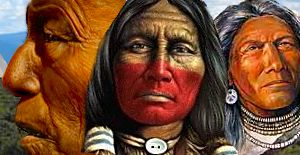 |
|
|
|||||||
| native american indian tribes of the US | |||||||
| |
||||||
One of the most famous AIM female american indian activists was a woman mysteriously murdered in early 1976...later identified as Anna Mae Pictou. More than 30 years later, the trials of her alleged murderers are just now in progress. |
Artifact Replicas|Jewelry|Clothing|Figurines|On Sale|New Products
Anna Mae Pictou Aquash, American Indian activistAnna Mae Pictou Aquash (also known as Anna Mae Pictou-Aquash or Anna Mae Pictou or Anna Mae Aquash; first name also spelled Annie Mae) stated in a letter written to a relative while she was in jail thirty years ago, that her Indian name was Naguset Eask, which means Sun Woman. She was born in a small Indian village near Shubenacadie, Nova Scotia, Canada, March 27, 1945. She became a Mi'kmaq activist who became one of the most active and prominent female members of the American Indian Movement (AIM) during the early 1970s. On February 24, 1976, during an early spring thaw, the dead body of Anna Mae Pictou was found by the side of State Road 73 on the far northeast corner of the Pine Ridge Reservation, about 10 miles from Wanblee, South Dakota. Although federal agents were present when the body was recovered, who knew Anna Mae, she was not identified. The Bureau of Indian Affairs' medical practitioner, W. O. Brown, missing the bullet wound on her skull, stated that she had died of exposure, and his autopsy report stated she had been dead for about ten days. Later, her hands were cut off and sent to the Federal Bureau of Investigation headquarters in Washington, D.C. for fingerprinting and her body was buried as a "Jane Doe." Three days later she was positively identified, and five days later her family was notified that she had died "of natural causes." The family got a court order to have her exhumed and a second autopsy was performed, revealing the real cause of death: a single .32 calibur bullet fired at close range into her skull. Rumors from AIM members alleged she was killed by the FBI to discredit AIM leaders. The FBI leaked rumors that she was killed by AIM members because they thought she was an FBI informant. No charges were filed against anyone until nearly thirty years later. On March 20, 2003 two men were indicted for the murder of Anna Mae Pictou Aquash: Fritz "Arlo" Looking Cloud, a homeless Lakota man, and John Graham (aka John Boy Patton), a Southern Tutchone Athabascan man from Whitehorse, Yukon, Canada who is a citizen of the Champagne and Aishihik First Nation . Although Theda Clark, Graham's adopted aunt, seems also to have been involved according to court testimony, she was not indicted. Theda Clark, now in her 80's resides in an undisclosed nursing home and is in failing health. On February 8, 2004 Arlo Looking Cloud was tried before a U.S. federal jury and five days later was found guilty. On April 23, 2004 he was given a mandatory sentence of life in prison. Although no physical evidence linking Looking Cloud to the crime was presented, a videotape was shown in which Looking Cloud admits to being at the scene of the murder but claims that he was unaware that Aquash was going to be killed. In that video, in which Arlo Looking Cloud is interviewed by Detective Abe Alonzo of the Denver Police Department and Robert Ecoffey, the Director of the B.I.A. Office of Law Enforcement Services, taped on March 27, 2003, he states that Graham was the triggerman. He also stated he was under the influence of alcohol at the time he gave the statement, which he now recants. Looking Cloud is currently appealing his conviction. John Graham is currently living in Vancouver, British Columbia. On June 22, 2006 his extradition to the United States to face charges on his alleged involvement in the murder was ordered by Canada's Minister of Justice, Vic Toews. Graham is appealing this order and is presently free on bail, but on house arrest. Graham emphatically denies any involvement in the death of Anna Mae. He claims that the U.S. government threatened to name him as the murderer of Anna Mae if he "didn't cooperate". Claiming that he last saw Annie Mae on a drive that took them from Denver to the Pine Ridge Indian Reservation, where he left her at a "safe house" (in his own words, in an interview with Antoinette Nora Claypoole), Graham explains why he believes he is being charged as her murderer: "...in the mid-80s or sometime about there. The FBI showed up at my home in the Yukon, and asked me all kinds of questions about Anna Mae and the death. They were trying to say I was there, or I knew about it, or I was aware of it. And I had to tell them I wasn't aware, I wasn't around there and I wasn't involved in her killing at all. And they wanted me to name leadership that would have given the order to that effect, to kill Anna Mae. And they were trying to tell me they would put me in the witness protection program, they would change my identity, they would relocate me if I would go to testify in front of the federal Grand Jury in South Dakota against the AIM leadership. So I told them I couldn't do that because it never happened. I never, ever received orders of any kind like that from any of the AIM leadership. And so I wouldn’t do it; I wouldn't cooperate with them. And they left. Then they came back a year or so later and said.... if I didn't cooperate with them to put this information on the AIM leadership, then I would be facing all these charges myself." The question of Graham's innocence or guilt has divided AIM and AIM leadership, with some (including John Trudell and Russell Means) arguing that he was, in fact, the triggerman and others arguing that he is merely a scapegoat. Annie Mae's Early YearsAquash's mother married Noel Sapier, a Micmac traditionalist, in 1949. A strong believer in the preservation of what was left of the Micmac culture and religion, Sapier brought discipline and emotional security to the family. He moved them to Pictou's Landing, another small Micmac reserve, and tried to make a living between seasonal farmhand jobs and traditional craftwork. Although they were still very poor, Aquash learned a great deal about the richness of her people's culture at this time. In 1953, Anna Mae was plagued with recurrent eye infections. By the time an Indian Department physician recognized the signs of tuberculosis of the eye, Anna Pictou had already developed tuberculosis of the lung. She recovered but was physically weak for some time afterward. In 1956, Noel Sapier died of cancer, and a new phase of Anna's childhood began. Until then, she had encountered racism mostly during trips to nearby towns. Now she went to an off-reserve school and was shocked by the way she was treated there. Although reserve schools were notoriously below standards, she maintained an A-average at the reserve school. By the end of her first year in public school, however, she was failing all her subjects. In later years, the activist would often talk about how the constant jeers, racial slurs, and lewd comments had ruined her school years. Aquash was not alone; most of her Micmac tribespeople followed the same pattern of failure when they enrolled in off-reserve schools. Aquash's difficulties with verbal and sometimes physical threats from classmates continued in high school. She steadily performed at lower and lower grade levels, but she stayed in school, something that many of her Indian classmates had not done. Her school problems were compounded in 1956, when her mother ran away to another reserve to marry Wilford Barlov. Anna Mae Pictou and her siblings came home to find that they had been abandoned. Annie May dropped out of school and turned to the only profession she knew, working the potato and berry harvest. New life in the big cityAt the age of 17, Anna Aquash decided to move to Boston with an aquaintance named Jake Maloney, who was aslo a MicMac. They found themselves in Boston in 1962, a strange, noisy, bustling world for people used to reserve life. The presence of many other Micmacs who had also moved there made the transition somewhat easier, though, and the couple soon settled in. Aquash began working in a factory and set up house with Jake. They considered themselves married and started a family. In 1964 and 1965, Aquash gave birth to daughters Denise and Deborah. Just after Deborah's birth, the couple married in New Brunswick and moved to another Micmac reserve. Although they had enjoyed life in Boston, they had mixed feelings about raising their daughters in such a big city, and they moved back and forth between Boston and the Maritime Provinces in Nova Scotia several times. During their stays in Canada, they immersed themselves in Micmac tradition, learning much from Jake's step-uncle, one of the few remaining Micmacs who kept to the old ways. Become a Community OrganizerIn 1968, Natives were calling for equal rights, cultural recognition, and the fulfillment of promises made in treaties. Aquash worked as a volunteer in the Boston Indian Council's headquarters while holding down her factory job. Her council work centered on helping young, urban Natives develop self-esteem, a technique that seemed to help them avoid alcohol abuse. It was a topic close to Aquash's own life. At this time she and Jake Maloney had broken off their marriage and, for a short period after the breakup, she frequently drank too much. She had also seen the havoc created by heavy drinking in Indian communities. At the Indian Council Aquash heard about a planned protest by AIM. A number of New England AIM members were joining with national leader Russell Means to protest the "official" version of Thanksgiving by converging on the Mayflower II, a reconstruction of the ship that carried the Pilgrims to America. The traditional story behind Thanksgiving was that the Pilgrims were greeted by- and shared a feast with--welcoming Indians. This version, of course, neglected to mention the legacy of conquest and slaughter that Europeans brought to the New World. Aquash participated in the protest and the event made her even more determined to work for Native rights. Aquash, along with her daughters, moved to Bar Harbor, Maine, to work in the Teaching and Research in Bicultural Education School Project (TRIBES). The girls attended the school and Pictou taught. The curriculum there consisted of traditional subjects as well as Indian history, values, and beliefs to foster pride in the students. Although the project was successful, it was closed in 1972, when funding was cut. The family returned to Boston, where Aquash enrolled in the New Careers program at Wheelock College. This program included both classroom instruction and community work. Pictou's assignment was teaching at a day care center in Roxbury, a predominately African American section of Boston. She excelled in the program and in her work, and was eventually offered a scholarship to attend Brandeis University in Massachusetts. Aquash declined the offer, preferring to continue her work in the black and Indian communities. The Trail of Broken Treaties MarchAround this time, she met and began a relationship with Nogeeshik Aquash, a Chippewa artist from Ontario. Together, they raised her daughters and became more involved in the growing Indian rights movement. In 1972 the couple participated in the march on Washington, D.C., called Trail of Broken Treaties. Originating with AIM, the march included Indians from all over the country who converged on the capital to draw attention to Indian issues. The group took over and occupied the Bureau of Indian Affairs building and then presented a list of 20 civil rights demands. After a week of occupation, the government promised to review their demands, point by point, a great victory and the first time a national organization of Indians had faced a confrontation as a united people. Several months later, in April of 1973, a group of 200 Indians, led by AIM, congregated at the site of the 1890 Wounded Knee massacre , in which 500 army soldiers opened fire on a group of Minneconjou Ghost Dancers, killing 300 men, women, and children. Wounded Knee, located near the Pine Ridge Reservation in South Dakota, was chosen as the place for protest because of its painful historical significance. AIM wished to draw public attention to its efforts against the reputedly corrupt administration of tribal chairman of the Oglala Sioux, Richard "Dick" Wilson, who used beatings and intimidation to rule the reservation. After hostilities increased, the town was occupied by 2,000 Indians in a siege lasting 70 days. When word of the occupation and resulting siege by federal troops reached Boston, Pictou and Nogeeshik left for South Dakota. Arriving several days later, they immediately busied themselves by sneaking food and medical supplies to the occupiers. Initially, they camped at Crow Dog's Paradise, the home of medicine men Henry Crow Dog and Leonard Crow Dog. Later, inside one of the stores at Wounded Knee, Aquash helped deliver Pedro, the first son of Mary Brave Bird, who would soon marry Leonard Crow Dog. On April 12, 1973, Anna Mae married Nogeeshik Aquash in a traditional Lakota (Sioux) ceremony presided over by Nicholas Black Elk and Wallace Black Elk. The standoff at Wounded Knee ended with the indictment of AIM leaders Dennis Banks and Russell Means. The Aquashes returned to Boston, where they continued their work for the movement. Aquash was on her way to becoming a national AIM leader. In 1974, she moved to St. Paul, Minnesota, to work in the AIM office there. Within a year, she was involved in the Menominee Indian takeover of an abandoned Alexian Brothers Catholic Monastery in protest of the termination of their federal Indian status. The conflict in Gresham, Wisconsin, ended peacefully, but from that time on, Aquash was constantly under FBI observation. Back to Wounded KneeDuring the summer of 1975, Aquash and AIM security chief Leonard Peltier attended an AIM conference in Farmington, New Mexico, to lend support to Navajo protests over mining in the Four Corners area. From there, they were called back to Pine Ridge to help organize security for Lakota traditionalists and AIM supporters who were being attacked by Wilson's provisional police force. They camped on the property of the Jumping Bull family. On June 26, 1975, a fight broke out between two FBI agents and AIM members. Two agents and a young Indian were killed. AIM members scattered as an international manhunt began for the FBI agents' killers. Peltier was later arrested, charged, and convicted of the murders of the two FBI agents. Three months later, in September 1975, Aquash was arrested with several others during a raid on the Rosebud Reservation in South Dakota. Fearing the worst, she jumped bail and went "underground" (hid from the law). In November, she was leaving the Port Madison Reservation in Washington State when federal agents began watching the two vehicles in the AIM caravan. In Oregon, just one mile short of the Idaho border, state troopers stopped the group and Aquash was again arrested. She was extradited to South Dakota in handcuffs to face charges from the raid at Rosebud, as well as federal charges of transporting and possessing firearms and dangerous weapons, including dynamite. Since she had not been indicted on the earlier charges, the South Dakota judge released her on bail; she fled again on November 24, 1975. On February 24, 1976, a Lakota rancher found Aquash's dead body while riding the perimeter of his property. Her body's deteriorated condition indicated that she had been dead for some time. The body was initially taken to the Pine Ridge Public Health Service for an autopsy. Her cause of death was listed as exposure, and since no one was able to identify her, she was buried as a "Jane Doe"--an anonymous corpse. Her hands were cut off and sent to FBI headquarters in Washington, D.C., for possible identification, and a week later, Aquash was identified. When her family was informed, they called on AIM to help them secure a second autopsy. On March 11, 1976, another post-mortem revealed a .32 caliber bullet hole at the base of Anna Mae's skull. Her death was then officially designated a homicide. Aquash was reburied with traditional rites, and the investigation of her murder began. When Leonard Peltier was arrested for the murder of the two FBI agents at Pine Ridge, the FBI based part of their case against him on the account of a witness. A Lakota woman, Myrtle Poor Bear, claimed she'd seen Peltier commit the murders. She later changed her story, saying that she had been coerced into identifying Peltier as the killer by an FBI agent, who had said she might meet the same end as Anna Mae Aquash. Aquash, whose murder had taken place right after Peltier's arrest, had earlier told the FBI she knew nothing about the murders of the agents and would not cooperate with them. Although two senators brought the matter before Congress and the Department of Justice, and although Canadian authorities demanded full accounting for the murder of one of their citizens on the federal land of a friendly neighboring country, the investigation never went far. Further Reading: Arrest finally made in murder of Anna Mae Pictou Aquash Leonard Peltier's lawyer releases statement after Arlo Looking Cloud trial |

What's New in the Gallery Store: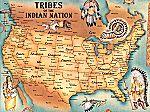 Native American Tribes by States Poster 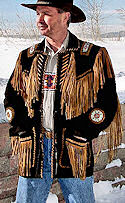 25 new fringed leather jackets 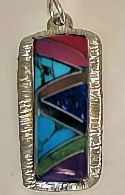 Zuni Style inlaid stone jewelry More New Products Most censored indigenous issues of 2007 The most censored issue of Indigenous Peoples by the media in 2007 was the “Silencing of traditional and grassroots’ voices by those in power,” according to readers voting on a poll of most censored indigenous issues at the Censored Blog. Billionaire donates $5 million to Crazy Horse Memorial A South Dakota billionaire banker has pledged a $5 million matching grant to the Crazy Horse Memorial Foundation, the largest ever in the mountain carving's nearly 60 year history. Restoring The Fundamental Human Rights Of Indigenous Peoples The revocation of the 15th century papal bull, Inter Caetera, will definitely announce before the world community that the Vatican no longer supports the principle of subjugation that it promulgated five and a half centuries ago. The Roman Catholic church will be demonstrating its seriousness about respecting the rights and dignity of all peoples. The revocation of Inter Caetera will be an extremely important spiritual and symbolic gesture of peace and healing in creating a culture of peace on earth. Congress petitioned for return of Geronimo's remains American Indians are petitioning Congress to investigate the elite Skull and Bones society at Yale University, who allegedly have the head of Geronimo. Sioux indian activists Profiles of sioux indian activists, activism, and issues that affect the Sioux tribe of Indians. ...More Articles 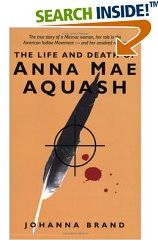 The Life and Death of Anna Mae Aquash 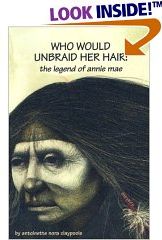 Who Would Unbraid Her Hair - The Legend of Annie Mae
Site Designed by: Mazaska Enterprises, LTD ©1999-2017 AAANativeArts.com Website Ranking file: Anna Mae Aquash |
|||||||||||||||||||||||||||||||||||||||||||||||||||||||||||||||||||||||||